How To Clean An Artichoke Step By Step
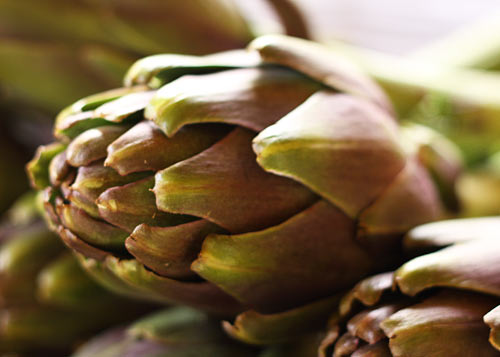
I love vegetables of all types, but if I had to choose my favorite, definitely the artichoke would be up there in the top three. Artichokes are relatives of the thistle, which isn’t surprising when you consider their appearance. The artichoke is native to North Africa and southern Europe and has been cultivated in Italy since Roman times.
In Italy there are three principal varieties of artichokes cultivated, which do not seem to resemble the larger, sturdy, commercial grown varieties available in North America. While living in Italy the first time, one of my favorite memories of spring was being in Venice and tasting my first tiny, purple spring carciofi or artichokes. Here in Umbria the larger, sturdier artichokes shown above are the type we find in the markets from late fall through to the spring.
Italians cook artichokes in almost every conceivable way, including braising, stuffing, stewing, frying, broiling, and grilling to name just a few. I am hoping that by explaining how to clean and prepare this misunderstood vegetable, perhaps I can get more people to try making them at home. Despite the fact that fresh, inexpensive artichokes are difficult to find here in North America, they often show up in markets in early spring.
There are certain qualities you need to look for when buying artichokes to ensure freshness. Look for tight, compact leaves, no wrinkling, and few brownish blemishes. Choose smaller, rather than the larger artichokes (unless you are planning on stuffing them) and those that feel heavier in your hands rather than light. The smaller variety generally has more edible leaves, and less prickly chokes. It is said if you rub two artichokes together and they squeak, then they are fresh.
Once you get your artichokes home from the market you then must clean and prepare them for your chosen recipe which may be a daunting proposition if you have never done it before. Having completed it once however, it will be a snap to do in the future, I promise! Everyone has a personal preference about how much of the artichoke they like to cut and what they leave on for cooking. This is how I would clean my artichokes for braising to be served as a side dish which is one of my favorite ways to enjoy fresh artichokes. You can find my easy Braised Artichoke Recipe below the step by step photos below.
How To Clean An Artichoke ~ Step by Step Photos
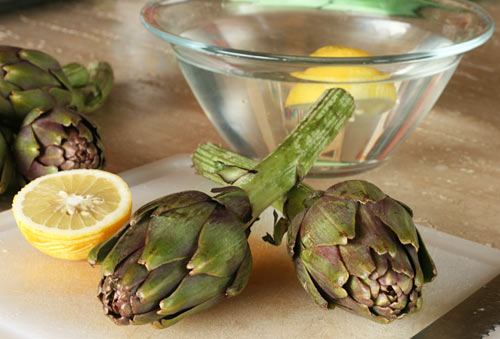
Before you start to clean your artichokes, take 1 lemon and cut it in half. Squeeze half into a glass or ceramic bowl and fill the bowl with cold water. Throw the squeezed lemon into the bowl reserving the other half to rub onto the cut surfaces of the artichoke as you clean it to prevent discoloration. You’ll also need a cutting board, serrated knife, small spoon, and a sharp paring knife.

First, cut off the top of the artichoke with a large serrated knife. As a general rule it is about 1/3 of the head of the artichoke. Rub the lemon briefly over the cut edge.
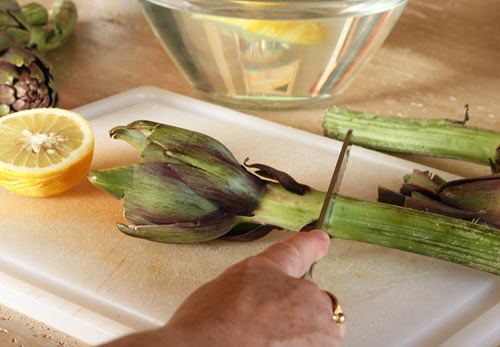
Next, cut the stem using the same knife. In North America you will rarely see artichokes in the marketplace with such long stems. I generally leave about 2 inches of stem on my chokes. The rest of the stem is still edible if you use a sharp knife and cut away the fibrous outer covering. Once cleaned, you can use the trimmed stem pieces in a delicious risotto or in pasta sauces or stews.
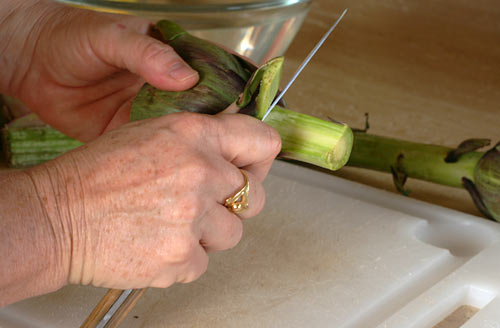
Next, take your paring knife and peel the outer fibrous portion of the stem all around starting at the bottom. As you reach the head of the choke, pull the knife up into the lower leaves and pull them off.
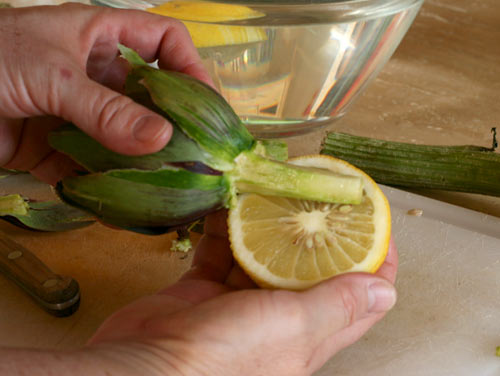
Rub the stem with your lemon half to prevent discoloration.
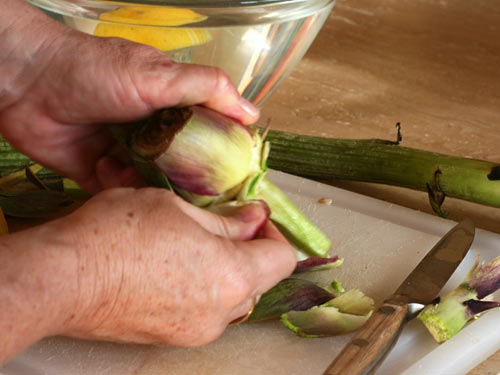
Begin at the bottom of the choke, start to pull off the darker, rough leaves with your fingers working your way around the choke and continue to do so until you only have light green leaves showing.
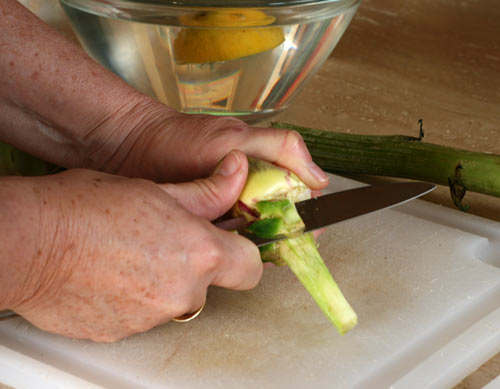
Take your paring knife and clean up the messy edge of the choke where you pulled off the leaves.
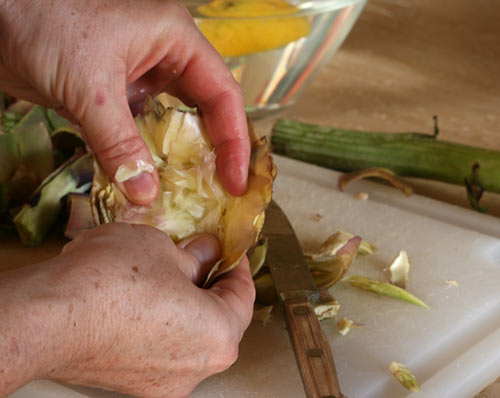
If you are cleaning baby artichokes you can simply ignore the inner spiky choke as it will be soft. For larger artichokes like I am cleaning in the photos, if I want to keep them whole I will pull apart the leaves to expose the sharp, spiky internal choke.
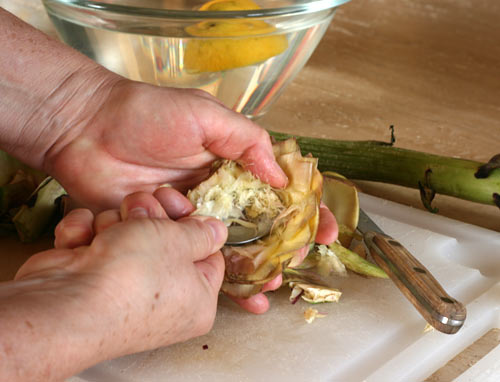
Once you have exposed the inner choke, simply use a sharp spoon to scoop it out.
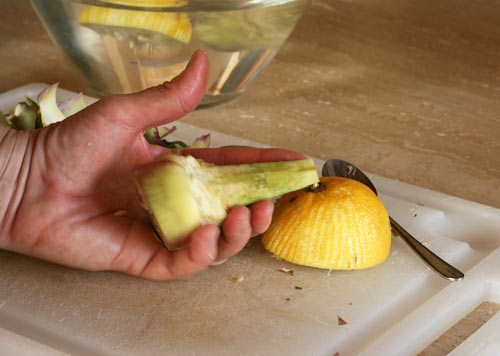
One perfectly cleaned artichoke ready for your favorite artichoke recipe!

If you do need need to keep the artichokes whole, (say if you are using them for sauces, risotto or stews) it is much easier to simply cut the artichoke in half and then scoop out the fuzzy and spiky inner choke.
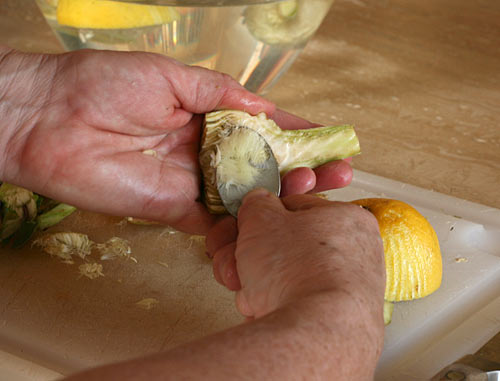
Using a spoon to scoop out the choke from an artichoke cut in half.
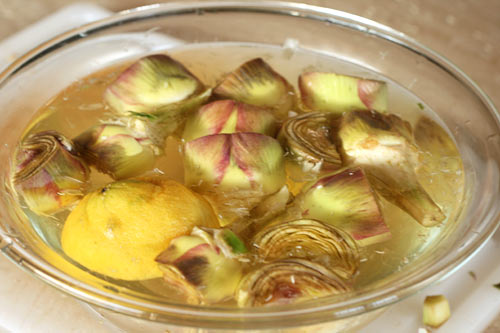
As you clean each artichoke, drop them into your lemon water to prevent discoloration until they are needed.
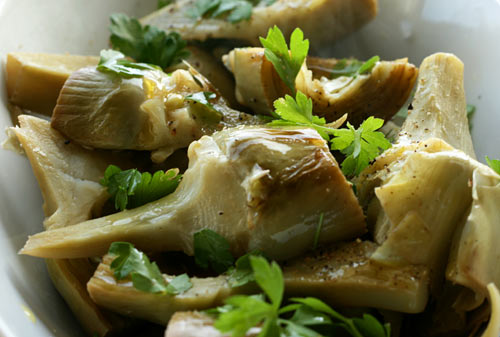
A delicious serving of braised artichokes. My hands down favorite way to enjoy fresh artichokes!
Deborah Mele
Just Beautiful! Great pics, thanks. I tried growing globe artichokes in NH, but this year, I am trying the Violetta artichokes in large pots so I can take them in to over-winter. I had seen some ot the purple ones with long stems and was intrigued. Thanks for the great recipes too.
After trimming off the outer dark green leaves, can these leaves then be steamed and served with a dipping sauce?
Barbara, I have found the leaves are too tough and have almost nothing edible on them.
At $3.00 a choke,I wouldn’t cut that much off. I cut about 3/4 inch,then trim the sharp points with scissors. Bang the cut side down on counter,rinse, and stuff with breadcrumb mixture.
Put in pot,add water to about halfway, salt and some olive oil and braise for about an hour.
Delicious
This is exactly the way my mother and my mother in law did them. My mom used the breadcrumbs and my mother in law did them with grated Romano cheese and sprinkled olive oil. My wife does them either way as we both have our preferences.
This is how I make them exactly. Why waste so much of a good thing !!! If I want to use them in recipes, I buy frozen hearts.